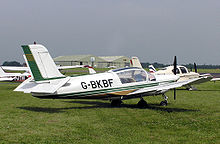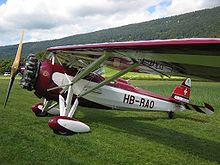Morane-Saulnier - Picture
|
Morane-Saulnier 
|
|
Morane-Saulnier

Picture - Morane-Saulnier Rallye Minerva MS.894A, built in 1970
Aéroplanes Morane-Saulnier is a French aircraft manufacturing company formed in October 1911 by Raymond Saulnier (1881-1964) and the Morane brothers, Leon (1885-1918) and Robert (1886-1968). The company was taken over and diversified in the 1960s.
History
Model development
Morane-Saulnier's initial production was the Model A, a continuation of a monoplane design produced by the previous Morane company (sometimes called Morane-Borel) using a wing-warping mechanism for control, in which Jules Védrines won the Paris-Madrid race on May 26, 1911.
Morane-Saulnier's first commercially successful design was the Morane-Saulnier G, a boxy looking wire braced shoulder wing monoplane with wing warping which led to the development of a whole series of aircraft and was very successful in racing, and setting records in its own right. The Type G was a single seater, and was enlarged slightly to make the Morane-Saulnier H, a 2 seater, and in parallel was given a faired fuselage to make the Morane-Saulnier N single seat fighter. The Morane-Saulnier H was modified so that its wings were mounted parasol fashion, above the fuselage to afford the observer a better view, creating the Morane-Saulnier L. The L was then fitted with a faired fuselage as on the N and ailerons to make the Morane-Saulnier LA, which was then completely redesigned (though looking very similar) to make the Morane-Saulnier P which would be the basis for a whole family of aircraft developed in the 20's. The Type N was developed into the larger and more powerful type Morane-Saulnier I and the very similar Morane-Saulnier V but these were not successful, being too powerful and having inadequate controls. The V was then redesigned to create the Morane-Saulnier AC which dispensed with a wing warping, and used a strut braced wing. The AC wasn't particularly successful, in part due to the poor visibility a shoulder mounting wing afforded, so the Morane-Saulnier AI was developed, which raised the wing above the fuselage. The AI lost out in the competition to the SPAD XIII but was built in limited numbers in case there was a problem with the SPAD though as it turned out, it was the AI that suffered structural problems. In parallel to the L the Morane-Saulnier BB was developed for the RFC, which was a Type P built as a biplane. Because the type 'BB' when pronounced in French sounds like Bebe (or baby), this became the type's nickname. Most of these types had no fixed fin, or horizontal stabilizer with the result that they were not only very sensitive on the controls, but could not even be flown hands off. One early pilot noted that if one left the aircraft to its own devices it would end up going upside down in the opposite direction. Despite this, many were used as trainers, including a great many that had their wings stripped so they couldn't fly, creating what was known as a Penguin.

Picture - Morane-Saulnier MS.317
The Type L has the distinction of being the first fighter aircraft during the early days of World War I when one was fitted with a machine gun firing through the propellor by Roland Garros. Although initially fitted with a synchronizer, the irregular rate of fire afforded by the gas-operated Hotchkiss machine gun he used meant it didn't work half the time, and he was reduced to fitting metal plates to armour the propellor. Bullets striking the back of the propellor were deflected off at an angle. Since the rate of fire was slightly less than the rate of rotation of the propellor this worked (though not perfectly) and Garros would become the first Ace. A similar system would be fitted to the Type N pending the arrival of other machine guns which made the system workable. While flying his modified Type L, Garros crashed on the German side of the lines and the wreckage was examined by Fokker just prior to Fokker producing a similar system.
After the war, Morane-Saulnier produced a number of designs for training and general aviation, but with the start of World War II looming it once again turned to military aircraft. During the late 1920s and early 1930s, it produced a number of parasol wing fighters including the M.S.230 and M.S.315, but all were of limited performance and were relegated to training duties. Moraine-Saulnier had much more success with its dramatically-modernized M.S.406, which was the Armée de l'Air's most numerous fighter at the start of the war. Unfortunately, the 406 was advanced only for its introduction in 1935 and suffered terribly against the more modern Messerschmitt Bf 109s it faced in 1940.
During World War II, Morane-Saulnier was operated under German control and built a number of German types including the Fieseler Storch, known after the war as the Morane-Saulnier MS.500 Criquet. Morane-Saulnier also produced a number of trainer and civilian aircraft models, the best known of which was the successful "Rallye" series of four-seat STOL semi-aerobatic tourers (see picture above).
Morane-Saulnier was purchased by Potez on January 7, 1962 and became SEEMS, the Societe d'Exploitation des Etablissements Morane-Saulnier. In 1966 its civilian models were spun off to form SOCATA, the Societe de Construction d'Avions de Tourisme et d'Affaires, which was eventually purchased by Aerospatiale.
Development of gun synchronisation
The company and Saulnier himself had a significant role in the development of the concept of synchronising machine gun fire through an aircraft's propellor.
Morane-Saulnier designs
Morane-Saulnier A
Morane-Saulnier B
Morane-Saulnier G
Morane-Saulnier H
Morane-Saulnier L
Morane-Saulnier LA
Morane-Saulnier N
Morane-Saulnier I
Morane-Saulnier V
Morane-Saulnier P
Morane-Saulnier T
Morane-Saulnier AC
Morane-Saulnier AF
Morane-Saulnier AI
Morane-Saulnier AN
Morane-Saulnier AR
Morane-Saulnier BB
Morane-Saulnier MoS-30
Morane-Saulnier MoS-43
Morane-Saulnier MoS-50
Morane-Saulnier MoS-53
Morane-Saulnier MoS-121
Morane-Saulnier MS-129
Morane-Saulnier MoS-130
Morane-Saulnier MS-130 Michelin Cup
Morane-Saulnier MoS-132
Morane-Saulnier MoS-138
Morane-Saulnier MoS-139
Morane-Saulnier MoS-147
Morane-Saulnier MoS-148
Morane-Saulnier MoS-149
Morane-Saulnier MoS-152
Morane-Saulnier MS-180
Morane-Saulnier MS-181
Morane-Saulnier MS-185
Morane-Saulnier MS-200
Morane-Saulnier MS-221
Morane-Saulnier MS-222
Morane-Saulnier MS-223
Morane-Saulnier MS-224
Morane-Saulnier MS-225
Morane-Saulnier MS-226
Morane-Saulnier MS-227
Morane-Saulnier MS-230
Morane-Saulnier MS-231
Morane-Saulnier MS-232
Morane-Saulnier MS-233
Morane-Saulnier MS-234
Morane-Saulnier MS-235
Morane-Saulnier MS-236
Morane-Saulnier MS-275
Morane-Saulnier MS-315
Morane-Saulnier MS-325
Morane-Saulnier MS-340
Morane-Saulnier MS-341
Morane-Saulnier MS-342
Morane-Saulnier MS-343
Morane-Saulnier MS-345
Morane-Saulnier MS-350
Morane-Saulnier MS-406
Morane-Saulnier MS-430
Morane-Saulnier MS-435
Morane-Saulnier MS-450
Morane-Saulnier MS.470 Vanneau
Morane-Saulnier MS-500 Criquet
Morane-Saulnier MS-502
Morane-Saulnier MS-505
Morane-Saulnier MS-570
Morane-Saulnier MS-571
Morane Saulnier MS.603
Morane-Saulnier MS-703 Pétrel
Morane-Saulnier MS.730 Alcyon
Morane-Saulnier MS-755 Fleuret
Morane-Saulnier MS-760 Paris
Morane-Saulnier MS-880 Rallye
Morane-Saulnier MS-880b Rallye
Morane-Saulnier MS-885 Super Rallye
Morane-Saulnier MS-893E
Morane-Saulnier MS-1500
http://www.aviafrance.com/constructeur.php?ID_CONSTRUCTEUR=931
Morane-Saulnier Pictures and Morane-Saulnier for Sale.
Living Warbirds: The best warbirds DVD series.
Source: WikiPedia